What animals can corals eat?
By Spencer Arnold
Corals are quite an amazing animal. For one thing, they farm micro-algae inside their bodies, from which they derive about 75-95% of their total energy supply. Through this symbiosis between the coral animal and the unicellular algae the corals can grow in waters that are nutrient deficient, and indeed it is in these super clean waters that corals are most productive – building reefs that are visible from space. But even though the corals get most of their energy from the algae they still need to feed to get the ‘fertilizer’ to give their algal crop. This feeding is done through the use of their tentacles, which wave around in the water and capture any food source that may happen by. But what is this food source?
Look it up in any book and you will see that corals eat zooplankton. So what is zooplankton? Technically, it is any animal (algae and cyanobacteria would by phytoplankton) that is in the water and cannot swim against currents. That is pretty broad, actually that definition can include small krill or brine shrimp as well as baby sea turtles, massive jellyfish, or a 10 meter long chains of sea salps. So more specifically we want to know what types of zooplankton corals eat, if there are differences in their diets between coral species, and what are some of the larger things they can eat?

Earlier this year we were conducting an Ecological Monitoring Program survey on the reef in Tao Tong, when one of our interns noticed something strange, a mushroom coral eating a sea slug. Not knowing if this was normal or not, he called over our resident sea slug guru, Rahul, to have a look (see the picture above). By the look on Rahul’s face and his display of excitement, it was obvious that this was not a normal thing to see.
The slug is part of an Order known as the Sacoglossans, which are unique in their ability to capture whole chloroplasts from their prey, and move them into their tissue as a sort of biological solar panel. This particular slug is known as Plakobranchus, and is actually quite common on our island, in the shallow sand beds and reefs. What is not common is to see corals feeding on it, as it is about 2-3 cm long and 1.5 cm wide. In fact, as we found out later, this is most likely the first ever record of a coral eating a sea slug, and one of the few records on what eats this particular sea slug.
A short article of the observation was published in the journal Coral Reefs, in March of 2015. This short article will add to the current scientific knowledge on what coral eat and what eats sea slugs, but still there is a long way to go in investigating this relationship. For example, we still need to know if this is normal, or if it was a fluke mistake on the part of the coral and it simply regurgitated it afterwards (a common rejection strategy in mushroom corals). Over the coming years, Rahul will be conducting research on a related topic, and adding to the knowledge out there. We hope that down the road and can know more about the specific diets of corals, as this information is relevant today as the oceans undergo dramatic changes in physical and biological make-up due to climate change and human activities.
You can find the online version of the article on Springer.com.
